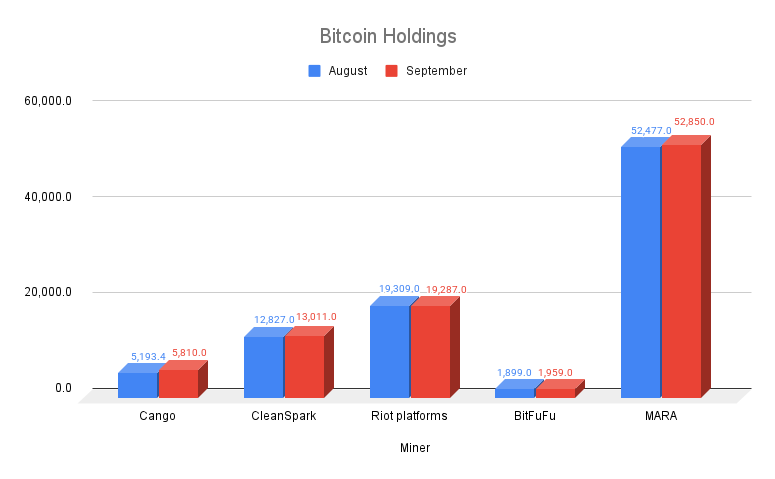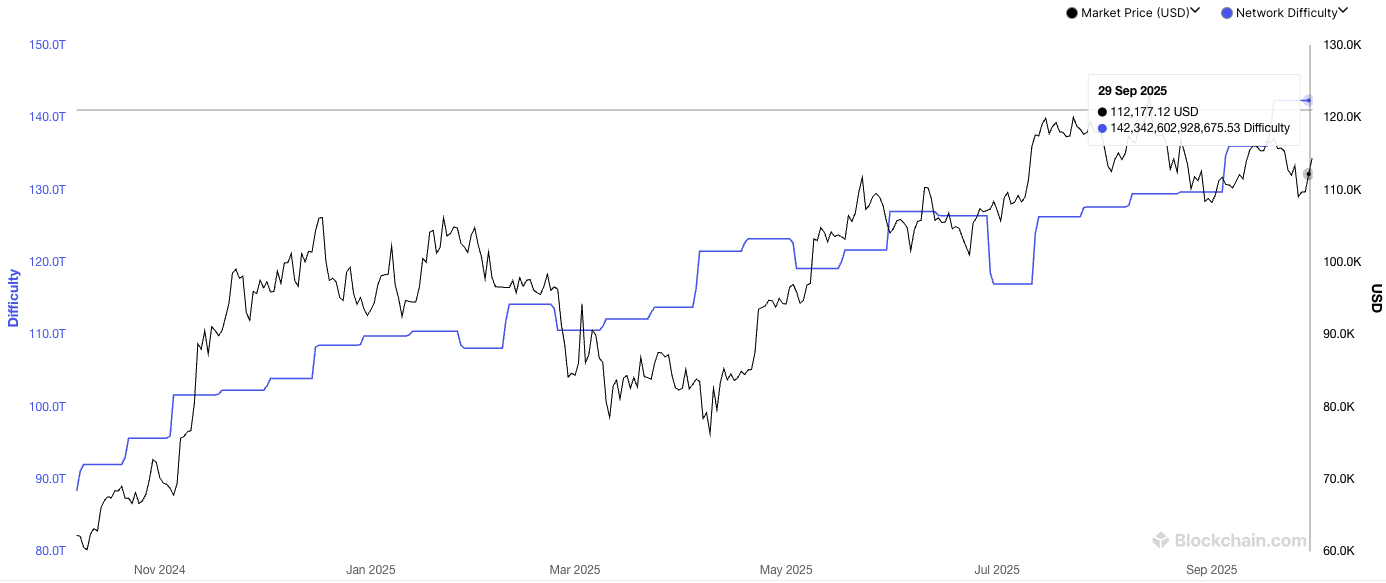Bitcoin Production in September Softens Amid Rising Difficulty — MARA Maintains Lead
September’s surge in Bitcoin mining difficulty squeezed profits across the sector, yet Marathon Digital (MARA) maintained its production lead. With efficiency now defining success, smaller miners face a challenging path amid rising costs and shrinking rewards.
Competition in the Bitcoin mining sector intensified in September 2025 as mining difficulty reached new all-time highs, while production across most major miners declined.
Large-scale companies with strong balance sheets and accumulation strategies continued to thrive in this environment, whereas smaller miners faced growing pressure from operational costs and technical volatility.
Bitcoin Production Declines as Difficulty Rises
According to publicly released reports, Cango mined around 616 BTC in September, down from 663 BTC in August.
CleanSpark produced 629 BTC, a slight dip from the previous month. Riot Platforms generated 445 BTC, compared to 477 BTC in August. BitFuFu’s output dropped sharply to 329 BTC, while Marathon Digital Holdings (MARA) maintained its lead with 736 BTC mined, further expanding its Bitcoin reserves.
 Bitcoin production by major mining companies. Source: BeInCrypto
Bitcoin production by major mining companies. Source: BeInCrypto
The data suggests that while larger miners managed to keep their production relatively stable, smaller operators began to feel the strain from rising difficulty and energy costs.
 BTC holdings of selected companies. Source: BeInCrypto
BTC holdings of selected companies. Source: BeInCrypto
Meanwhile, Bitcoin’s network difficulty climbed to 142.34T in September, marking a new all-time high. This consistent increase in difficulty means that each unit of hashrate now yields fewer BTC, driving hashprice (revenue per unit of computational power) lower.
As a result, miners’ profit margins continue to tighten, especially for those with higher energy costs or less efficient hardware.
 Bitcoin mining difficulty. Source:
Blockchain.com
Bitcoin mining difficulty. Source:
Blockchain.com
Notably, a new anti-Bitcoin mining bill in New York recently proposed a progressive tax on Bitcoin mining companies, with revenue redirected to lower utility bills for residents. The bill faces uncertain prospects but could disrupt multi-billion-dollar data center plans and increase cryptocurrency regulation in the state.
In summary, Bitcoin production in September revealed mounting technical pressure on the mining industry. As difficulty keeps rising and profit margins shrink, large miners like MARA, which have efficient infrastructure and a strategy of BTC accumulation, remain in a strong position.
Smaller firms must carefully consider selling BTC, cutting power capacity, or scaling operations to navigate the increasingly competitive and volatile landscape.
Disclaimer: The content of this article solely reflects the author's opinion and does not represent the platform in any capacity. This article is not intended to serve as a reference for making investment decisions.
You may also like
Strategic Collaborations Between Public and Private Sectors: Driving Real Estate and Industrial Expansion in Underdeveloped Areas
- Public-private partnerships (PPPs) are transforming underserved regions by bridging infrastructure gaps and driving real estate and industrial growth. - Projects like Madrid Nuevo Norte and Costa Rica's affordable housing initiatives demonstrate PPPs' ability to boost property values and create jobs through mixed-use development and public land utilization. - U.S. data reveals racial disparities in PPP benefits, with communities of color experiencing lower baseline home values despite similar growth rate

ICP's 30% Price Jump: Key Factors and What It Means for Web3 Investors
- ICP surged 30% in late 2025 due to upgraded on-chain governance and tokenomics, enhancing decentralized control and utility-driven demand. - Network Nervous System (NNS) reforms simplified neuron activation, boosted developer participation, and introduced periodic voting reaffirmations. - Caffeine AI integration and partnerships with Microsoft/Google drove TVL to $237B, though dApp usage declined 22.4% amid macroeconomic volatility. - Analysts project $11.15–$31.89 price range for 2026, contingent on sus

New Prospects in EdTech for STEM and Renewable Energy Sectors: Strategic Integration and Sustainable Investment Opportunities
- Global decarbonization and tech innovation drive surging demand for STEM and renewable energy skills, but talent shortages persist. - Universities modernize curricula with quantum computing, AI ethics, and sustainable engineering to align with industry needs and green job targets. - EdTech bridges gaps through AI-driven personalized learning, VR/AR simulations, and cloud-based hybrid models, enhancing accessibility and practical training. - EdTech market projected to grow at 13.3% CAGR to $348B by 2030,

AAVE Rises 1.13% as Weekly Increase Balances Out Monthly Decline During Market Fluctuations
- Aave (AAVE) rose 1.13% in 24 hours, rebounding from a 39.1% annual decline amid crypto market volatility. - The 12.3% weekly gain reflects speculative buying in DeFi, though broader trends show 17.68% monthly losses. - Analysts highlight DeFi's fragility due to regulatory uncertainty and shifting capital flows, despite short-term optimism. - Aave's future depends on innovation, macroeconomic stability, and competition from emerging lending platforms.

